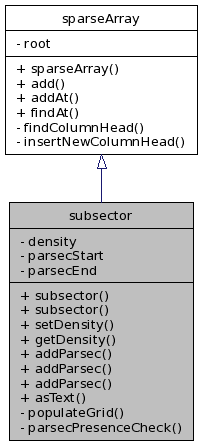
#include <subsector.hpp>
Inheritance diagram for subsector:

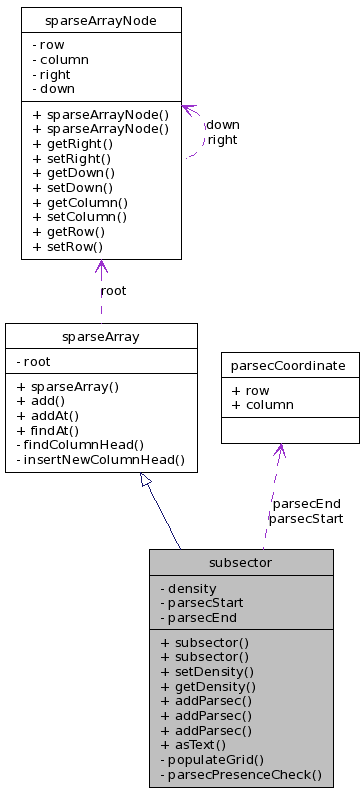
Definition at line 41 of file subsector.hpp.
Public Member Functions | |
| subsector () | |
| subsector (int position) | |
| void | setDensity (int d) |
| int | getDensity () |
| void | addParsec (parsec *p) |
| void | addParsec (int row, int column, parsec *p) |
| void | addParsec (int row, int column) |
| char * | asText () |
| subsector::subsector | ( | ) |
A non-parametized constructor for generating subsectors of the book 3 nature.
Definition at line 43 of file subsector.cpp.
References parsecCoordinate::column, and parsecCoordinate::row.
00043 { 00044 density=DENSITY_NORMAL; // This is the default from book 3 00045 00046 parsecStart.row=1; 00047 parsecStart.column=1; 00048 parsecEnd.row=10; 00049 parsecEnd.column=8; 00050 00051 this->populateGrid(); 00052 00053 }
| subsector::subsector | ( | int | position | ) |
Generic constructor
| position | -- Integer offset into the sector this subsector belongs to |
Definition at line 55 of file subsector.cpp.
References parsecCoordinate::column, and parsecCoordinate::row.
00055 : sparseArray() { 00056 int row; 00057 int column; 00058 00059 density=DENSITY_NORMAL; 00060 00061 parsecStart = markers[position-1]; 00062 parsecEnd.row=parsecStart.row+9; 00063 parsecEnd.column=parsecStart.column+7; 00064 00065 this->populateGrid(); 00066 00067 00068 }
| void subsector::addParsec | ( | int | row, | |
| int | column | |||
| ) |
Last form of this: add a parsec to the place given, but generate a new parsec from within the method.
| row | integer value of the row | |
| column | integer value of the column |
Definition at line 89 of file subsector.cpp.
References sparseArray::addAt().
Here is the call graph for this function:
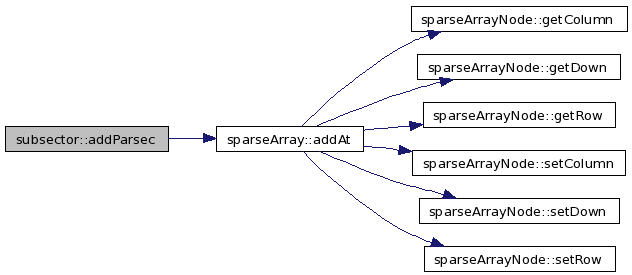
| void subsector::addParsec | ( | int | row, | |
| int | column, | |||
| parsec * | p | |||
| ) |
Add parsec at the location provided, set the parsec's row and column accoridingly.
| row | integer value for the row | |
| column | integer value for the column | |
| p | pointer to a parsec object. |
Definition at line 95 of file subsector.cpp.
References sparseArray::addAt().
00095 { 00096 this->addAt(row,column,p); 00097 }
Here is the call graph for this function:
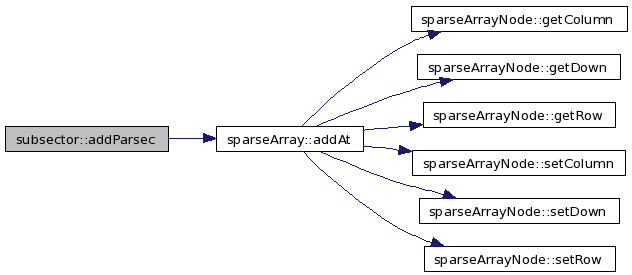
| void subsector::addParsec | ( | parsec * | p | ) |
Add a new parsec to this subsector. The row and column in this case being used for placement is embedded in the parsec object itself.
| p | pointer to a parsec to add |
Definition at line 81 of file subsector.cpp.
References sparseArray::addAt(), sparseArrayNode::getColumn(), and sparseArrayNode::getRow().
00081 { 00082 int row = p->getRow(); 00083 int column = p->getColumn(); 00084 00085 this->addAt(row,column,p); 00086 00087 }
Here is the call graph for this function:
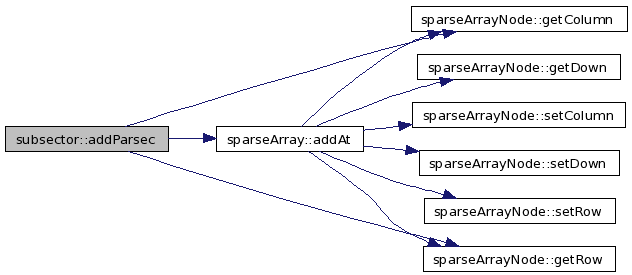
| char * subsector::asText | ( | ) |
Create one very large array of characters representing the subsector (in a book 3 layout) and return a pointer to it.
Definition at line 120 of file subsector.cpp.
References parsec::asText(), parsecCoordinate::column, and parsecCoordinate::row.
00120 { 00121 int row; 00122 int column; 00123 char *buffer; 00124 00125 buffer = (char*) malloc(128); 00126 buffer[0]='\0'; 00127 sprintf(buffer,"%s\n\n","********** Subsector Listing ***************"); 00128 00129 00130 for(row=parsecStart.row;row<=parsecEnd.row;row++){ 00131 for(column=parsecStart.column;column<=parsecEnd.column;column++){ 00132 parsec* p = (parsec *)this->findAt(row,column); 00133 if ( p!= 0 ) { 00134 char *newtext = p->asText(); 00135 char *newBuffer = (char*) malloc(strlen(newtext)+strlen(buffer)+10); 00136 newBuffer[0]='\0'; 00137 sprintf(newBuffer,"%s%s\n",buffer,newtext); 00138 free(buffer); 00139 buffer=newBuffer; 00140 } 00141 } 00142 } 00143 return buffer; 00144 }
Here is the call graph for this function:

| int subsector::getDensity | ( | ) |
get the density attribute
Definition at line 71 of file subsector.cpp.
| void subsector::setDensity | ( | int | d | ) |
set the density attribute
| d | integer value for density |
Definition at line 75 of file subsector.cpp.
 1.4.7
1.4.7